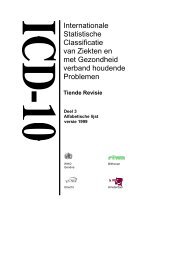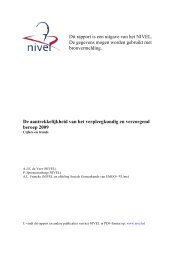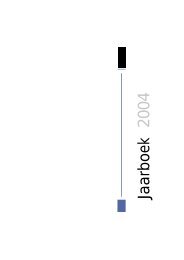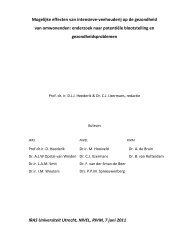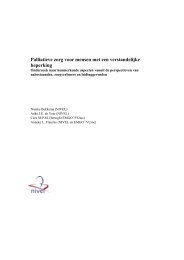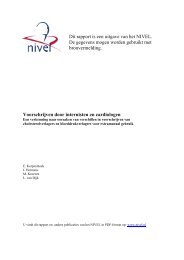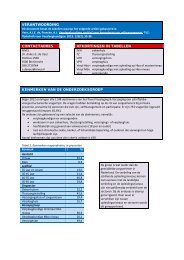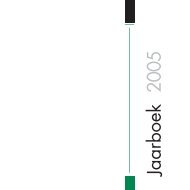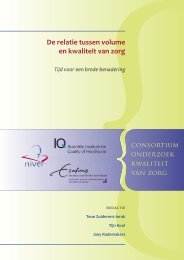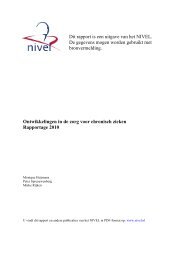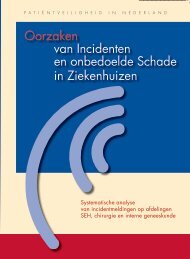Multi-Sensory Stimulation in 24-hour Dementia Care - Nivel
Multi-Sensory Stimulation in 24-hour Dementia Care - Nivel
Multi-Sensory Stimulation in 24-hour Dementia Care - Nivel
Create successful ePaper yourself
Turn your PDF publications into a flip-book with our unique Google optimized e-Paper software.
ecomes less common after age 75, while the <strong>in</strong>cidence of Alzheimer’s disease<br />
cont<strong>in</strong>ues to rise (APA, 1997). The relationship between Alzheimer’s disease and<br />
vascular dementia is complex, because recent evidence suggests that small strokes<br />
may lead to <strong>in</strong>creased cl<strong>in</strong>ical expression of Alzheimer’s disease (Snowdon et al.,<br />
1997).<br />
The rema<strong>in</strong><strong>in</strong>g types of dementia account for a much smaller fraction of the total<br />
(APA, 1997). Other types of dementia are for <strong>in</strong>stance dementia due to Lewy body<br />
disease, dementia due to Park<strong>in</strong>son’s disease, dementia due to Pick’s disease and<br />
other frontal lobe dementias, dementia due to Hunt<strong>in</strong>gton’s disease or Creutzfeldt-<br />
Jakob disease, and dementia due to medical conditions (e.g., structural lesions, head<br />
trauma, endocr<strong>in</strong>e conditions, nutrition conditions).<br />
<strong>Dementia</strong> is often accompanied by behavioural and psychological disturbances that<br />
can be highly problematic for patients and caregivers. The International Psychogeriatric<br />
Association has def<strong>in</strong>ed Behavioural and Psychological Symptoms of<br />
<strong>Dementia</strong> (BPSD) as ‘signs and symptoms of disturbed perception, thought content,<br />
mood or behaviour that frequently occur <strong>in</strong> patients with dementia’ (APA, 1997).<br />
BPSD, such as aggression, agitation, depression or apathy, occur and are problematic<br />
<strong>in</strong> up to 97 percent of the cases (Buettner et al., 1996).<br />
<strong>Dementia</strong> <strong>in</strong> nurs<strong>in</strong>g homes<br />
Mental and functional loss forces a large number of elderly people with dementia to<br />
move to nurs<strong>in</strong>g homes. A nurs<strong>in</strong>g home is def<strong>in</strong>ed as an <strong>in</strong>stitution provid<strong>in</strong>g<br />
nurs<strong>in</strong>g care <strong>24</strong> <strong>hour</strong>s a day, assistance with activities of daily liv<strong>in</strong>g and mobility,<br />
psychosocial and personal care, paramedical care, such as physiotherapy and<br />
occupational therapy, as well as room and board. Nurs<strong>in</strong>g homes usually provide care<br />
that can be characterised as the ‘highest level of care’ (Ribbe et al., 1997). In the<br />
Netherlands there are 330 nurs<strong>in</strong>g homes, with a total of 57,000 beds (27 per 1000<br />
<strong>in</strong>habitants aged 65 and older). About 2.5% of the population above 65 years stay <strong>in</strong><br />
nurs<strong>in</strong>g homes and another 6.5% <strong>in</strong> residential homes or homes for the aged with a<br />
lower level of care (Ribbe et al., 1997). The Dutch nurs<strong>in</strong>g home is a healthcare<br />
<strong>in</strong>stitution for chronically ill persons <strong>in</strong> need of permanent complex nurs<strong>in</strong>g care and<br />
is comparable to skilled nurs<strong>in</strong>g facilities <strong>in</strong> the United States. It differs from nurs<strong>in</strong>g<br />
homes <strong>in</strong> other countries <strong>in</strong> that the staff <strong>in</strong>cludes nurs<strong>in</strong>g assistants, specially<br />
tra<strong>in</strong>ed nurs<strong>in</strong>g home physicians, psychologists, activity therapists, speech therapists,<br />
physical therapists, nutrition assistants, and others, all of whom are employed by the<br />
nurs<strong>in</strong>g home (Hoek et al, 2000). Medical care is provided by specially tra<strong>in</strong>ed<br />
physicians, who are employed by the nurs<strong>in</strong>g home, with an average ration of one<br />
full-time doctor per 100 beds (Ribbe et al., 1997). Residents are admitted to nurs<strong>in</strong>g<br />
homes for several reasons: 50% require long-term <strong>in</strong>stitutional care, 40% use<br />
predom<strong>in</strong>antly rehabilitative services, 5% have a term<strong>in</strong>al illness and another 5%<br />
Introduction 11



